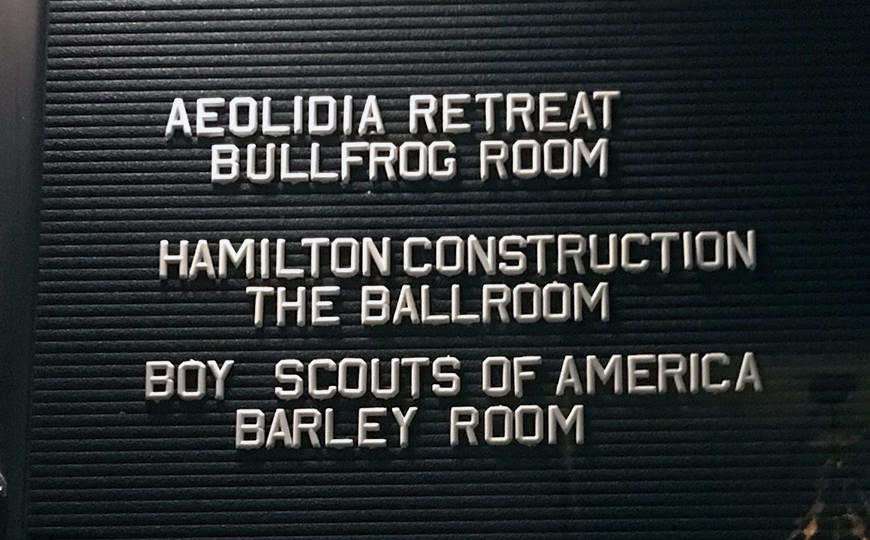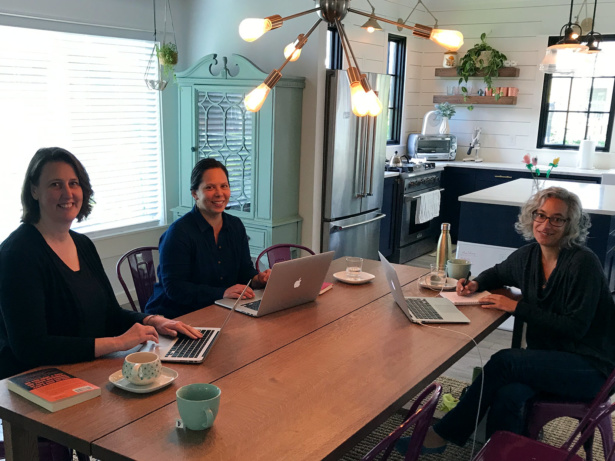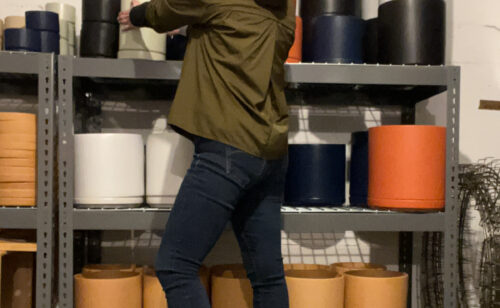
8 Questions to Create Strong Growth For Your Business
Have you heard of EOS, the Entrepreneurial Operating System? We use it as a 20-person service-based business, and I think it would work well for shop owners, too, either with employees or even if you’re a solopreneur.
I read a book a few years ago that really changed my business. It was called Rocket Fuel, and was about how two people with two different personalities can be the necessary ingredients to make a business work really well. I found out that I had been operating as the Visionary of Aeolidia, while Sam was the Integrator, making my vision actually work.
The book also had a lot of advice for how to structure a “real” business, and tips for using that good foundation to grow a great business. I followed up by reading Traction, by the same authors, and Get a Grip. These books outline what the authors call the Entrepreneurial Operating System (EOS), which is a structure for running a small business.
Now, this system is set up around an organizational chart (expanded and called an Accountability Chart) in the EOS system, which means you are thinking about the different departments of your company (leadership, operations, sales, marketing, finance, human resources). This might seem like overkill if you have a one or two-person business. But Sam and I drew up our Accountability Chart early on, even though it was either me or her in all roles on that chart! It turned out to be really helpful to think of our business as much bigger than it was, because it helped us realize all we were trying to do and gave us a new perspective on how to tackle it.
I wanted to share with you today the parts of the Entrepreneurial Operating System that have been most helpful to us, and that are great to consider for any size business, even if your business is just you right now. If you do have a team, I think the entire system is worth learning more about, as it has helped us identify and make progress on important goals.
The core concept that EOS centers around is something that is (somewhat clunkily) called the Vision/Traction Organizer (V/TO). Knowing the vision for your business, and figuring out how to make progress on it (Traction), is such a big deal.
Here are eight questions you can answer for your business which will give you a clear picture of what you are doing and why.

Entrepreneurial Operating System: The vision for your business
Part of your vision is recognizing what your business is about. The rest is where you want to be, and what your marketing strategy for that is.
1. Core Values
Your core values are the guiding principles for your company, and when you have a team, you should hire, fire, review, reward, and recognize people based on them. When the business is just you or you and a partner, the core values may end up being more important as far as communicating who you are to potential customers and partnerships.
I outlined Aeolidia’s core values, then brought them to my team of 20 to get their feedback, adjustments, and additions, and now we all have a document that we relate to, and can use for internal decisions, determining our fit with clients, and marketing our business.
You can read the detailed descriptions of each of our core values here, and the quick overview is below. Each person who works at Aeolidia is a:
- Diligent achiever
Committed to exceeding expectations on each and every project. - Curious learner
Continuously improves skills and knowledge and challenges assumptions. - Humble expert
Confident about own work, open-minded, and ego never gets in the way. - Positive ally
Proactively takes responsibility and finds win-win solutions. - Creative supporter
Enthusiastic about helping small designer businesses succeed.
What are the 3-7 things that exemplify you, your employees, and how you want to run your business?
2. Core Focus
Your Core Focus has two parts. It is your Core Purpose (your “reason for being,” a grand, big-picture view of your passion or cause), and your Niche.
For weekly tips like this, subscribe to our newsletter
"*" indicates required fields
EOS has a checklist to help you find your Core Purpose:
- It’s stated in three to seven words.
- It’s written in simple language.
- It’s big and bold.
- It has an “aha” effect.
- It comes from the heart.
- It involves everyone.
- It’s not about money.
- It’s bigger than a goal.
At Aeolidia, we settled on:
Creating connection through storytelling
Our clients sell products that are special to their customers because the customers feel a connection with the brand’s values, purpose, or story. It’s not just drop-shipped goods from bulk manufacturers, but something unusual and interesting and just right for just the right people. And our job at Aeolidia is to create that connection by telling our clients’ stories well.
The Niche is more specific than the purpose, and Aeolidia’s niche is:
Growing creative ecommerce businesses through strategic design
What about you? Why does your business exist? And what niche can you use to filter all your decisions through, to see if they’re a good fit for your company?
3. Your 10-year target
Your ten-year target is not meant to be modest. In fact, in Traction, they compare it to the Big, Hairy, Audacious Goals described in the book Built to Last. This should be a larger-than-life goal that gives direction to everyone in the company. Figure out how far out you’d like to look, and then dream big for your business. Where do you want to take it? How much revenue would you like your business to make?
4. Your marketing strategy
The marketing strategy is a big part of the vision, with a lot of pieces to it. I’m not going to cover it in huge detail, but the briefest overview is that you’ll want to consider:
- Your target market, the list of people who might buy from your company. We talk about finding a target customer here.
- Your three uniques. What three things, when put together, make you meaningfully different than your competitors? This one is such a big deal, and something I’ve been pushing over and over on our blog for years. We have posts on our blog about differentiation and unique selling proposition.
- Your proven process. This is the exact set of steps you follow to do what it is your business does. Having this nailed down and communicated can be very compelling to your customers, as well as instructive to you and your internal team.
- A guarantee. Is there any part of what you do that you can offer a guarantee to your customers about? That can do a lot towards making it easy to shop from you.
We require the first two bits of information from each of our clients, so we’re able to tell their stories well. The other two are great for you to have as well, and can be worked into your marketing and sales materials.
5. Your 3-Year Picture
For the three-year picture, you set the date three years in the future, and figure out what you want to accomplish by then. What will your revenue be? How much of that will be profit? What specific measurables can you pinpoint that will let you know if you’ve reached your goal or not? Maybe something about how much traffic your site will get? Your conversion rate? How many wholesale partnerships do you have?
Finding your 10-year, 3-year, 1-year, and then quarterly expectations, as the EOS system does, reminds me of the hugely helpful advice in the book, The One Thing, which I break down here. Each one of these dated goals is a domino that knocks down a bigger and bigger domino until you get to that final big goal.

Entrepreneurial Operating System: Getting traction toward your goals
Once you’ve figured out the vision, the next part is to find a way to achieve it. This involves figuring out what you’re doing short term. What is your plan for this year, what steps do you need to take to achieve it, and what issues are you having that may be standing in your way?
Here’s what you will need:
6. Your one-year plan
The three-year plan is your vision, but the one-year plan is what you’re actually going to get done this year. What do you want to get accomplished by the end of this year to have you on track for that three-year picture?
Since this is work you will be acting on and completing this year, make sure each goal you set is specific, measurable, and attainable. How do you then attain these goals? “Rocks” have been working wonders for us:
7. Company rocks
“Rocks” are named for the analogy of having a vase to fill with rocks, gravel, and sand. If you start with the sand and gravel (busywork and smaller tasks), there won’t be any room to fit your big rocks in the vase. If, however, you put the rocks in first, the gravel and sand will fill in the empty spaces, and everything will fit.
So your rocks are your top priorities for each quarter of the year that must get done. Everything else will fall into place. Base these on your goals for the year, and check in with yourself or your team weekly to see if you’re on track for each rock.
Rocks should be specific, measurable, and attainable, as your one-year goal is, above. This means that when you get to the end of the quarter, you should be able to easily say “yes” you accomplished it, or “no” you didn’t.
Each person in your company should have 3-5 rocks per quarter. If you accomplish less than 80% of your rocks, you may be trying to pack too much in.
8. Your issues list
So many things come up all the time when you’re running a busy business! It’s easy to feel like you spend all of your time putting out fires, or that there are fires quietly burning in the back room that never get put out. The issues list takes care of that.
Each week, you can have a meeting in each department (or one meeting if your business is smaller, or just a check-in with yourself if you work solo). You brainstorm all the current issues, then pick the top three from that list. Then you have the time limit of the meeting (ours is 90 minutes) to solve each issue forever. If you get through the top 3, pick the next most important 3, then solve those as well.
Setting aside time to smoke out and resolve issues leaves the rest of your time free to make progress on your rocks so you can meet your bigger goals.
The Entrepreneurial Operating System in a nutshell
That’s EOS in a nutshell! There is, of course, quite a bit more to it, specifically the yearly, quarterly, and weekly meetings that keep everything humming like a productive beehive. Just figuring out the Vision, above, is such a great foundation for your business. Then putting a plan in place to make things happen should be your next step.
If you have a system that isn’t working well or don’t have a system for setting and meeting goals, I’d urge you to check out the following books (all links to go to my favorite bookstore, Powell’s in Portland, OR):
- Traction – most useful as an overview of the whole system
- Rocket Fuel – particularly helpful if you have or need an Integrator or Visionary to balance your own tendencies
- The ONE Thing – not EOS-related, but another great and complementary way to figure out how to prioritize and meet goals
If you have employees, taking the Organizational Checkup test together may be helpful, too! There are also a lot of tools and guides on the EOS site.
In many cases, a good way to hire help before you can hire a full-time employee is to outsource work to experts. So, consider Aeolidia your team if you need help with your brand or your website. Download our rate sheet here, and then let’s talk!
A Newsletter That Goes Beyond Shopify 101
It’s easy to find beginner info about ecommerce online. If you’re past that? Subscribe to our newsletter for advanced strategies and need-to-know info for established shops. You'll get:
- Weekly tips to help you market and sell your products
- Updates when there is news that may impact your site
- Round ups of interesting links and info for brands
- Invites to our live trainings and webinars
- Instant access to our past emails
"*" indicates required fields
Related Posts
Let's take your online shop to the next level
The Shopify websites we design have a reputation for substantial improvements to ecommerce conversion rates and online sales. Let's talk!















